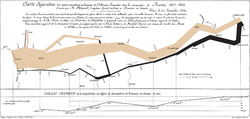
Sankey diagram
Encyclopedia

Flow diagram
Flow diagram may refer to:* Alluvial diagram, highlights and summarizes the significant structural changes in networks* Flowchart, schematic representation of a process which can give a step-by-step solution to a given problem....
, in which the width of the arrows is shown proportionally to the flow quantity. They are typically used to visualize energy
Energy
In physics, energy is an indirectly observed quantity. It is often understood as the ability a physical system has to do work on other physical systems...
or material
Material
Material is anything made of matter, constituted of one or more substances. Wood, cement, hydrogen, air and water are all examples of materials. Sometimes the term "material" is used more narrowly to refer to substances or components with certain physical properties that are used as inputs to...
or cost
Cost
In production, research, retail, and accounting, a cost is the value of money that has been used up to produce something, and hence is not available for use anymore. In business, the cost may be one of acquisition, in which case the amount of money expended to acquire it is counted as cost. In this...
transfers between processes.
Application
Sankey diagrams are used to visualize flow quantities in process systems. They are also commonly used to visualize the energy accounts or material flow accounts on a regional or national level. Sankey diagrams put a visual emphasis on the major transfers or flows within a system. They are helpful in locating dominant contributions to an overall flow. Often, Sankey diagrams show conserved quantities within defined system boundaries, typically energyConservation of energy
The nineteenth century law of conservation of energy is a law of physics. It states that the total amount of energy in an isolated system remains constant over time. The total energy is said to be conserved over time...
or mass, but they can also be used to show flows of non-conserved quantities such as exergy
Exergy
In thermodynamics, the exergy of a system is the maximum useful work possible during a process that brings the system into equilibrium with a heat reservoir. When the surroundings are the reservoir, exergy is the potential of a system to cause a change as it achieves equilibrium with its...
.
One of the most famous Sankey diagrams is Charles Minard's Map of Napolean's Russian Campaign of 1812. It is a flow map
Flow map
Flow maps in cartography are by definition of Phan "a mix of maps and flow charts, that show the movement of objects from one location to another, such as the number of people in a migration, the amount of goods being traded, or the number of packets in a network".- Overview :Flow maps according...
, overlaying a Sankey diagram onto a geographical map. It was created in 1869.
Sankey diagrams are named after Irish Captain Matthew Henry Phineas Riall Sankey
Matthew Henry Phineas Riall Sankey
Matthew Henry Phineas Riall Sankey CB, CBE was an Irish engineer from County Tipperary who created the Sankey diagram. He served as a captain of the British Army in the Royal Engineers until leaving to become an engineer...
, who used this type of diagram
Diagram
A diagram is a two-dimensional geometric symbolic representation of information according to some visualization technique. Sometimes, the technique uses a three-dimensional visualization which is then projected onto the two-dimensional surface...
in 1898 in a publication on the energy efficiency
Energy conversion efficiency
Energy conversion efficiency is the ratio between the useful output of an energy conversion machine and the input, in energy terms. The useful output may be electric power, mechanical work, or heat.-Overview:...
of a steam engine
Steam engine
A steam engine is a heat engine that performs mechanical work using steam as its working fluid.Steam engines are external combustion engines, where the working fluid is separate from the combustion products. Non-combustion heat sources such as solar power, nuclear power or geothermal energy may be...
(see reproduction in, page 8). While the first charts in black and white were merely used to display one type of flow (e.g. steam), using colors for different types of flows has added more degrees of freedom to Sankey diagrams.
Another example is the United States Energy Use developed by the US Department of Energy's Lawrence Livermore Laboratory.
See also
- ThermodynamicsThermodynamicsThermodynamics is a physical science that studies the effects on material bodies, and on radiation in regions of space, of transfer of heat and of work done on or by the bodies or radiation...
- Material flow managementMaterial flow managementMaterial flow management is a method of efficiently managing materials.Material flow management is the goal oriented, efficient use of materials, material streams and energy. The goals are given by ecological and economical areas and by observing social aspects...
- Grassmann diagram (exergy flow and loss)
External links
- Scottish Executive - Energy in Scotland: Supply and Demand
- Irish Environmental Protection Agency - Material Flow Accounts (MFAs) – Demonstration for Ireland - 2001]
- sankey-diagrams.com - comprehensive website about Sankey diagrams including links to a range of software tools

